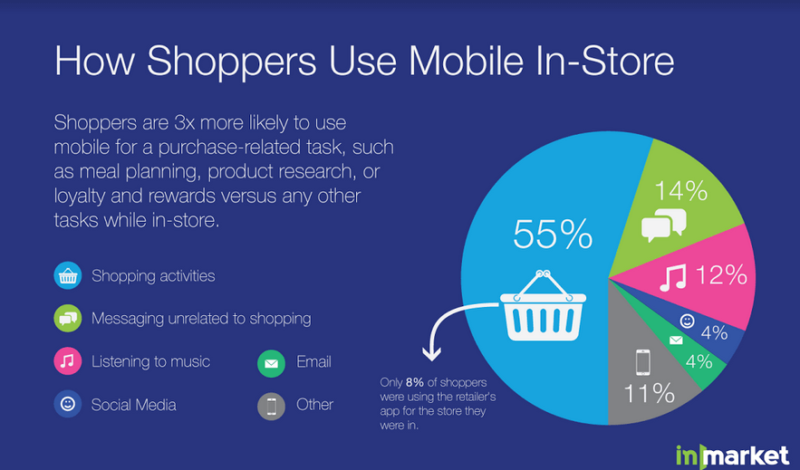Study says only 8 percent of shoppers use retailer apps. Should they give up?
No: they need a diversified strategy that includes third party distribution, mobile wallets and a renewed focus on the usability of their apps and sites.
It’s very well established that consumers use smartphones as shopping assistants in stores. We’re now getting into the nuances of how they use them and how marketers and retailers can be more effective in tapping that in-store usage.
A new survey from inMarket offers some insights and a bit of contradictory data to the growing body of information about in-store smartphone usage. The company examined the mobile shopping behaviors of 2,500 US smartphone owners who used their devices in stores.
Conducted between July and September, the study’s primary finding is that the most common in-store smartphone use case is shopping-related research (55 percent). No surprise there. What follows is “messaging unrelated to shopping” and “listening to music.”
In the survey, a minuscule 4 percent of shoppers were using social media in stores. That finding is directly contradicted by a study from Euclid Analytics, which found that Facebook was widely used in-stores. While the specific uses of the Facebook weren’t explored in the Euclid research, the strong implication is that the app is being used for shopping-related activity.
Euclid also found a much higher percentage (83 percent) of its sample (1,500 consumers) used smartphones as part of in-store shopping vs. the 55 percent in the InMarket research. Some of these differences show why no single study can be taken as entirely representative of consumer behavior. One has to look at the directional trends across multiple pieces of research.
Both studies found usage of retailer apps in-stores is a minority use case. However, the inMarket research found a smaller percentage (8 percent) of consumers are using a retailer’s app than the Euclid study. The point is that most consumers are not using the retailer’s own apps.
There are several explanations for why retailers have struggled to gain adoption for their apps. The simple one is that most retailers’ apps fail to make a compelling case for downloads and continued usage. They fail to offer the convenience and features that consumers want and only the most loyal and frequent shoppers are likely to use them.
However, a mobile wallet strategy can provide some of the same capabilities as a branded app (e.g., notifications) but in a more lightweight package that’s more likely to be adopted. Indeed, all retailers should have a mobile wallet strategy, to complement their mobile app and web assets.
The inMarket study operates as something of an argument that retailers should work with third parties with greater distribution — and by implication abandon their own app development efforts. While they must work with third party distribution points, they must also work relentlessly to improve their apps (and mobile sites), consistent with the recommendations in the Euclid study, And they should utilize mobile wallets as this case study clearly shows.
Retailers have been talking for a long time about putting the consumer at the center of an omni-channel strategy. There are many organizational barriers to executing against this vision — but execute they still must.
Opinions expressed in this article are those of the guest author and not necessarily MarTech. Staff authors are listed here.
Related stories

